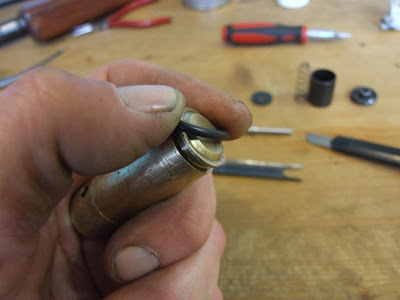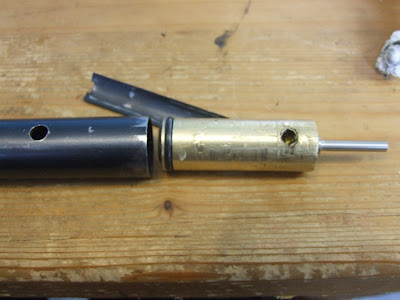 |
| See how the back of the trigger pushes the sear block upwards? |
So to start with, I tap the pivot pin for the trigger out most of the way until the trigger could be removed.
 |
| Gently tap out the pivot pin for the trigger. |
With that done, the sear and return spring came out of the housing.
 |
| This sear has different dimensions from the one that comes with the sear liner. |
Then, with a small screw driver, I worked the metalplate out from an access point on the side ...
 |
| Unhook the steel liner from this point and out it comes. |
... this is there to stop wear and tear on the plastic in the breach, this is L shaped with a a small tab to lock it in place.
 |
| The sprung steel liner stops wear and tear on the plastic of the breech |
I cut a number of shaped pieces from thin plastic from a disposable food carton; these were placed between the metal and the plastic wall of the housing.
 |
| I had to take the rifle apart to get the sear out as it was wedged in with too many shims, bloody nightmare that was. |
I found one was perfect; when I tried two it was too tight and believe me it took a fair bit of effort to free the sear from where it had wedged itself in. So back to one shim and in went the spring ...
 |
| One thin plastic shim was perfect. |
... the sear and then the trigger was lined up and the pivot pin was tapped back into place.
 |
| Line up the hole in the trigger and the pivot pin and gently tap in with a rubber mallet. |
The trigger works fine now with no free movement of the sear back and forth, I could've got away without doing it but why the hell not?! Besides, you get to see how the trigger and sear assembly is put together.
All the best.
Wing Commander Sir Nigel Tetlington-Smythe





















































